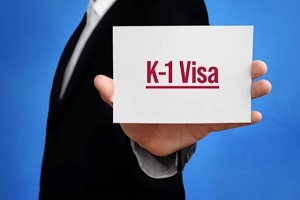Have you connected with the love of your life abroad and now want them to join you in the United States so you can marry and start your new life together? The K1 fiancé visa permits the foreign fiancé of an American citizen to enter the U.S. for this purpose.
But not every couple automatically qualifies for this special visa; there are several eligibility rules that must be met to get approved for a K1 visa.
What the U.S. Citizen Petitioning Partner Must Show
To petition for a K1 fiancé visa for your loved one, you will need to prove you are a U.S. citizen. Provide documentation such as your U.S. birth certificate, passport, or naturalization certificate. As the petitioning partner, you also vow to financially support your fiancé, demonstrating an ability to support them at 125% above the poverty line.
This can be demonstrated with recent tax returns, pay stubs, bank statements, or other records. Additionally, you must prove your relationship with your fiancé is legitimate. This means showing you meet the definition of fiancés under immigration law.
You and your fiancé must be free to wed from a legal standpoint, with no existing marital entanglements. Long-distance relationships are common, but officials want to see if you have spent time together, with at least one face-to-face meeting in the previous two years, before granting a K1 visa.
What the Foreign Fiancé Partner Must Show
As the foreign fiancé, you must genuinely be engaged to the American citizen sponsoring you. Provide evidence such as photos, emails, and other records showing your relationship history. To qualify for the K1, you must have met your fiancé in the past two years, barring exceptional circumstances.
You must also be legally eligible to marry your fiancé once in the U.S. Be able to provide documents proving any prior marriages were lawfully dissolved through annulment, divorce, or death. You will be required to undergo a medical exam to confirm that you do not have any contagious diseases or conditions making you inadmissible.
One key factor that could affect eligibility is having immigration violations or a criminal record. Even a minor issue could cause problems. Be prepared with police certificates from anywhere you lived for over six months after age 16. Answer all immigration forms honestly, as officials will check for any criminal history or character concerns, and any misinformation can lead to denial.
Foreign Partner and the K1 Visa Application Process
Once you have been determined to meet the basic requirements, your fiancé will submit Form I-129F to U.S. Citizenship and Immigration Services (USCIS). This petition describes your relationship and intent to get married within 90 days of your arrival in the U.S. Your fiancé should include:
 Proof of U.S. citizenship
Proof of U.S. citizenship- Birth certificate
- Records proving your relationship
- Evidence you have met in the past two years
After USCIS approves the I-129F, you can proceed with the visa application. You will complete the DS-160 form and set up an interview at the nearest U.S. embassy or consulate. Here are key documents to have for your K1 visa interview:
- Valid passport (six months beyond U.S. entry)
- Birth certificate
- Police certificates from all countries lived in over six months after age 16
- Medical exam from an authorized physician
- Two passport photos
- Proof your U.S. fiancé will support you financially
At the visa interview, you must convince the officer you meet all requirements. Answer every question honestly, as inconsistencies could raise red flags. If they require more information, they will get in touch with you directly. Hopefully, your visa will be approved within days after a successful interview.
Entering the U.S. on a K1 Visa
Once approved, you will be issued a K1 visa valid for six months. During this time, you can join your fiancé in the U.S. to get married. You are admitted initially for 90 days on your K1 visa with the understanding that you must wed within this 90-day period. Once married, you can file to get a green card. If you do not marry within 90 days, you must depart the U.S.
The K1 does not allow you to change to another visa, attend school, or work in the U.S. The sole purpose of the K1 is to immigrate through marriage to the petitioning partner. Do not enter the U.S. too far before the day on which you plan to get married.
Work quickly with your fiancé to get a marriage certificate upon arrival and submit your green card application. This will permit you to remain in the U.S. legally during processing.
K1 Visa Denials
Despite best efforts, not all K1 applications are approved. Reasons for denial can include:
- Failing to prove you met your fiancé within two years
- Not providing enough evidence your relationship is real
- Inadequate proof of financial support
- Past immigration violations, criminal issues, or other inadmissibility factors
- Inconsistencies in your story or misinformation
A denial can be devastating, but depending on the situation, you might be able to reapply or appeal the decision. Be ready to directly address any concerns raised in your new application. Gather as much supplemental documentation as possible; with enough evidence and legal support, many couples overcome an initial denial.
Trust Pride Immigration to Help You Understand and Meet All K1 Requirements
The K1 visa presents a wonderful chance to bring your foreign fiancé to the U.S. Thoroughly document your entire relationship history and any legal/financial issues. Carefully review the visa requirements and have all the necessary documentation when you go for your interview. Being prepared with a complete petition will help avoid the disappointment of denial.
If you need guidance with your K1 visa application, the seasoned professionals at Pride Immigration are here to assist you. We have years of experience successfully assisting couples with fiancé visas. Contact us today at (703) 594-4040 or online, and let us help you make your dreams of marrying in the U.S. come true.
Beeraj Patel, Esq.
Latest posts by Beeraj Patel, Esq. (see all)
- Impact of Life Changes on Green Card Applications - June 16, 2025
- Common K1 Visa Criminal Background Issues - June 2, 2025
- Does Social Media Have an Impact on Your K1 Visa Application? - May 19, 2025
